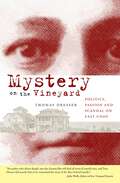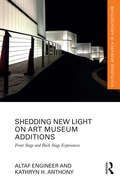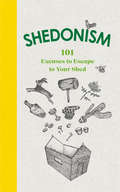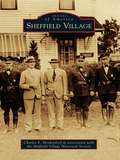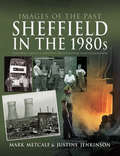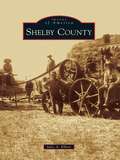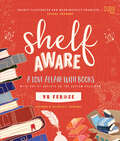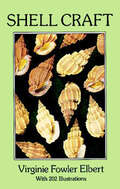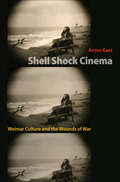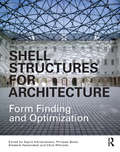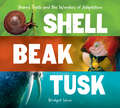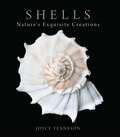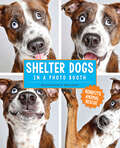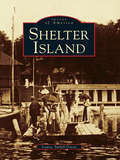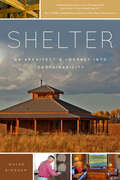- Table View
- List View
Shear Terror (A Sewing Studio Mystery #3)
by Dorothy HowellThe latest novel in a crafting cozy series featuring talented sleuthing seamstress Abbey Chandler, the members of a small-town California sewing studio—and murder. Abbey&’s life in Hideaway Grove is comfortable, and she&’s grateful for her small sewing studio in the back room of her aunt&’s bakery, but she&’s feeling stuck. Her plan to expand her custom tote bag business by selling to a chain of gift shops has hit a snag. Making enough totes to distribute to all the stores requires large-scale production—which requires money Abbey doesn&’t have. To make ends meet, she takes a part-time job at the town&’s bustling Visitor Center . . . Abbey is soon sorting items with her co-workers for the Visitor Center&’s annual Lost and Found Day when unclaimed items are displayed and offered for sale. Thanks to tourism, there&’s enough to fill a huge stockroom. But something is amiss. Eleanor Franklin, devoted to all things Hideaway Grove, hasn&’t shown up for work—and when Abbey discovers her whereabouts, it isn&’t pretty . . . Eleanor is dead inside a clothing bin, dressmaker shears impaled in her chest—shears the sheriff reports are engraved with Abbey&’s name. Under suspicion, Abbey will have to launch her own investigation. But who would want to kill thoughtful Eleanor, a model resident always so full of good advice about how to uphold Hideaway Grove&’s high standards? As it turns out, not everyone appreciated Eleanor&’s advice . . . Now Abbey will have to cut through a tattered trail of greed, theft, and revenge to sew up the case before a killer cramps her style—for good . . .
Sheboygan Tales of the Tragic & Bizarre (American Chronicles)
by William F. WangemannThe untold stories of the tranquil town of Sheboygan, Wisconsin, that have been swept under the rug or lost over the years.Sheboygan deserves its reputation as a conservative city clean, quiet and law-abiding. But here are some stories that have been swept under the rug or lost overboard. Venture into the mists of the "Lake Michigan Triangle" that have swallowed boats, planes and entire tribes. Investigate speakeasy shootings, safes burgled by a fly swatter, poisoned Christmas candy, flaming shipwrecks and the hoax that had militiamen firing on their own cattle. Or just sit down with some bizarre anecdotes about a hometown you thought you knew, from the town's first baseball game to the man freed from jail by a jug of whiskey to the deputy sheriff who had to enforce Nicholas Hoffman's first bath in 50 years.
Shedding New Light on Art Museum Additions: Front Stage and Back Stage Experiences (Routledge Research in Architecture)
by Kathryn H. Anthony Altaf EngineerVast sums of money spent to design, construct, and maintain museum additions demand great accountability of museum leaders and design professionals towards visitors and employees. Museum visitors today come not only to view works of art, but also to experience museum architecture itself, resulting in most major cities competing to build new museum additions or new museum buildings to become world class tourist destinations. Shedding New Light on Art Museum Additions presents post-occupancy evaluations of four high-profile museums and their additions in the United States and helps museum stakeholders understand their successes, shortcomings, and how their designs affect both visitors and employees who use them every day. The book helps decision-makers assess the short-term and long-term impacts of future proposals for new museum additions and illuminates the critical importance of investing in employee work environments, and giving serious consideration to lighting, wayfinding, accessibility, and the effects of museum fatigue that arise from the lack of public amenities. Museum leaders, curators, architects, designers, consultants, patrons of the arts and museum visitors will find this book to be a useful resource when planning and evaluating new building additions.
Shedonism: 101 Excuses to Escape to Your Shed
by Ben WilliamsFind yourself, in your shed.Turn your she-shed or man cave into your own private escape with 101 simple, practical ideas.Take some well-deserved alone time and learn to preserve lemons and chillies, whittle a butter knife, tie your own fishing flies, keep chickens, plant a roof garden or make a camera obscura.Why not transform your shed itself? This book is full of inspiration for anyone who has dreamed of having an observatory, a sauna, a pub – or just a bit of peace and quiet at the bottom of the garden.The perfect gift for anyone who would rather be in their shed.
Sheffield Village
by Charles E. Herdendorf Sheffield Village Historical SocietyThe Village of Sheffield was founded on the Lake Erie plain and a sandy ridge of glacial Lake Warren. Black River and French Creek course through rich farmlands, once home to Archaic and Woodland Indians. Originally surveyed as Township 7 of Range 17 in the Connecticut Western Reserve, hearty pioneers arrived here in 1815 from the Berkshire Mountains of New England, naming their settlement Sheffield after their Massachusetts town. In the mid-1800s, another wave of immigrants arrived from Bavaria, adding cultural richness to the community. In 1894, industrialist Tom Johnson constructed giant steel mills on the west side of the river, and Sheffield Village eventually broke away, choosing to retain its agrarian identity. Today Sheffield Village is in transition to a modern residential/commercial community but keeps much of its natural character by virtue of parklands along stream valleys. Fortunately, fine examples of homestead architecture have been preserved throughout the village.
Sheffield in the 1980s (Images of the Past)
by Mark Metcalf Justine JenkinsonA visual portrait of a British city and its people fighting to survive an era of industrial decline, captured by a steelworker-turned-photographer.The social, industrial, and economic changes imposed on the Sheffield area during the 1980s are captured with remarkable clarity in this volume featuring the work of steelworker-turned-photographer Martin Jenkinson. Like many northern England and Scottish cities during that decade, Sheffield went through troubled times, even as parts of southeast England, especially the City of London, boomed. The gap between north and south became a chasm.Jenkinson photographed people in their everyday lives at work and at play. However, where he particularly excelled was his work with the trade union and labor movement, in workplaces and on protests, demonstrations, and pickets. Some of the images in this book capture joy and laughter; some portray suffering. They provide a loud cry for social justice, a better world where unemployment is no more, poverty is swept away, and everyone, black and white, male and female, can enjoy a life where their talents are used for the collective improvement of all. In reflecting on the not-so-distant past, Jenkinson’s photographs are about a world we still must aim to obtain.
Shelby County
by Julie A. ElbertShelby County has a rich and interesting history. Shelby County was created in 1827 and originally included almost all of Moultrie County, Pana, Assumption, and most of Praireton Township in Christian County. Today it is still one of the largest counties in Illinois. The county seat, Shelbyville, is historically linked to Abraham Lincoln, who made numerous visits to Shelby County during his circuit riding days. Early pioneers found abundant wildlife in the forests and prairies. In the 1840s, the pioneers began to break the prairie and found fertile soil. The arrival of the railroad spurred the rich agricultural history of the county that continues to this day. Samuel Moulton, state representative and U.S. congressman from Shelbyville, introduced the bill that established the Illinois Free Public School System. Chautauquas were presented at the Auditorium in Shelbyville, which still exists today, and at Lithia Springs. More than a dozen cities, towns, and villages combine to create a fascinating history of this county.
Shelf Aware: A Love Affair with Books
by V.R. FeroseBIBLIOPHILIA: A perfectly acceptable addiction marked by obsessive reading, aggressive book-sniffing and strategic hoarding.For as long as Ferose, a San Francisco-based techie and 'gently mad' bibliophile, has understood books, he has devoured them with the unmitigated enthusiasm of a toddler on a sugar rush. For him, reading has been more than a weekend pursuit or a hobby on steroids. It has been a lifestyle - generously peppered with serendipitous first edition finds and deliberate in-store title hunting - of which he kept meticulous notes. In this intimate and refreshingly honest essay collection - illustrated by artists on the autism spectrum - Ferose professes his undying love for books and elaborates on his relationship with the life-affirming act of reading. Enthusiastically noting titles that carry scribbles in the neglected margins to gushing over one-of-a-kind collectibles, he delves into his varied picks, bringing his most formative bookish adventures to readers. Part memoir and part fascinating study of the quiet, fulfilling act of reading and collecting books, this joyous meld of anecdotes and recollections explores the sweeping genius of books and storytelling, and how they continually refine our collective conscience.
Shell Art: A Handbook for Making Shell Flowers, Mosaics, Jewelry, and Other Ornaments
by Helen K. KraussThis is a guide to for making many realistic flowers by gluing shells and adding paint and stems. It also illustrates the art of making mosaics, jewelry, and ornaments, using shells.
Shell Craft
by Virginie Fowler ElbertSince ancient times, seashells have provided both materials and design inspiration for a variety of arts and crafts. Shell-inspired motifs have turned up in pottery and floor mosaics, as architectural ornaments, and on furniture. The magnificent mollusks have also been used as money and decorative objects to adorn the body. This comprehensive guide by Virginie Fowler Elbert -- noted author, crafter, and authority on shell lore -- offers a wealth of craft ideas for using these lovely treasures from the sea.Following a fascinating introduction to the use of shells throughout history, the simply written text provides step-by-step instructions for cleaning, preparing, and displaying shells; suggests methods for decorating boxes and mirror frames; and shows how to create fanciful soap dishes, night lights, and jewelry items -- from pendants and necklaces to bracelets, cuff links, and earrings.You'll also find easy-to-follow directions for preserving shells in resin to make paperweights, napkin holders, cachepots, and other household accessories, as well as instructions for casting shell forms from molds (an ideal way to develop multiple patterns if only a few shells are available). There's even a chapter on how to do shell printing with linoleum blocks and crayon prints to create distinctive designs for placemats, wall hangings, wrapping paper, and stationery. Reference works and an updated list of supply sources round out this profusely illustrated guide to a fun-filled and rewarding pastime.
Shell Shock Cinema: Weimar Culture and the Wounds of War
by Anton KaesHow war trauma haunted the films of Weimar GermanyShell Shock Cinema explores how the classical German cinema of the Weimar Republic was haunted by the horrors of World War I and the the devastating effects of the nation's defeat. In this exciting new book, Anton Kaes argues that masterworks such as The Cabinet of Dr. Caligari, Nosferatu, The Nibelungen, and Metropolis, even though they do not depict battle scenes or soldiers in combat, engaged the war and registered its tragic aftermath. These films reveal a wounded nation in post-traumatic shock, reeling from a devastating defeat that it never officially acknowledged, let alone accepted.Kaes uses the term "shell shock"—coined during World War I to describe soldiers suffering from nervous breakdowns—as a metaphor for the psychological wounds that found expression in Weimar cinema. Directors like Robert Wiene, F. W. Murnau, and Fritz Lang portrayed paranoia, panic, and fear of invasion in films peopled with serial killers, mad scientists, and troubled young men. Combining original close textual analysis with extensive archival research, Kaes shows how this post-traumatic cinema of shell shock transformed extreme psychological states into visual expression; how it pushed the limits of cinematic representation with its fragmented story lines, distorted perspectives, and stark lighting; and how it helped create a modernist film language that anticipated film noir and remains incredibly influential today.A compelling contribution to the cultural history of trauma, Shell Shock Cinema exposes how German film gave expression to the loss and acute grief that lay behind Weimar's sleek façade.
Shell Structures for Architecture: Form Finding and Optimization
by Chris Williams Philippe Block Sigrid Adriaenssens Diederik Veenendaal*** Featuring a foreword by Pritzker Prize Winner Shigeru Ban *** Bringing together experts from research and practice, Shell Structures for Architecture: Form Finding and Optimization presents contemporary design methods for shell and gridshell structures, covering form-finding and structural optimization techniques. It introduces architecture and engineering practitioners and students to structural shells and provides computational techniques to develop complex curved structural surfaces, in the form of mathematics, computer algorithms, and design case studies. • Part I introduces the topic of shells, tracing the ancient relationship between structural form and forces, the basics of shell behaviour, and the evolution of form-finding and structural optimization techniques. • Part II familiarizes the reader with form-finding techniques to explore expressive structural geometries, covering the force density method, thrust network analysis, dynamic relaxation and particle-spring systems. • Part III focuses on shell shape and topology optimization, and provides a deeper understanding of gradient-based methods and meta-heuristic techniques. • Part IV contains precedent studies of realised shells and gridshells describing their innovative design and construction methods.
Shell, Beak, Tusk: Shared Traits and the Wonders of Adaptation
by Bridget HeosWe think of evolution as a tree with branches that make clear, linear sense—with one animal and its traits clearly derived from one that came before it genetically. But what about animals who share key traits but aren’t on the same family tree? This is called convergent evolution, and it’s the big idea that Bridget Heos tackles in a kid-friendly way in Shell, Beak, Tusk. From mammals to reptiles, and everything in between, Heos manages to make some intriguing comparisons—and bring to life theories of evolution and convergentevolution in bite-sized, easily digested chunks of fun facts, illustrated with full-color photography throughout.
Shells: Nature's Exquisite Creations
by Joyce TennesonJoyce Tenneson,s detailed photographic studies of luminous sea shells adrift on a velvet-soft background remind us that startling beauty exists even in the most ordinary places. These surprising images give us a unique window into these secret lives of the sea. Short selected quotes from literature illuminate these ethereal portraits.
Shelter Dogs in a Photo Booth
by Guinnevere ShusterThis uplifting, fun collection of photographs and biographies of rescue dogs is the perfect gift for animal lovers.Man's best friend! What better way to showcase adoptable dogs than by letting their true personalities shine in a photo booth! In the tradition of the best-selling dog photography book, Underwater Dogs, Shelter Dogs in a Photo Booth wins the heart of all dog lovers.Often seen as sad, rejected, and behind cold metal bars, it's no wonder people would avoid images of shelter dogs awaiting forever homes. From talented photographer (and now public figure and adoption champion) Guinnivere Shuster comes Shelter Dogs in a Photo Booth, a guaranteed-to-make-you-smile photo book featuring rescued dogs in a brand-new light. Get ready to see the cutest canine portraits you’ve ever seen, along with a short stories about the dog’s personality and how the dog ended up in the shelter, and the adoption date. Guinnevere’s fantastic photos have been featured on websites, in magazines, and on television programs all over the world: Good Morning America, NBC, ABC, MSNBC, The Huffington Post, Time, The Daily Mail . . . even celebrities have gotten in on the action: Amy Poehler, Cesar Millan, and Zooey Deschanel have made statements and posts declaring their love of Guinnevere’s work. After the adorable and up-for-adoption photos of these furry friends were seen and enjoyed by millions, adoption rates at Utah's Humane Society skyrocketed.A portion of the proceeds of this book will benefit the Humane Society of Utah and Best Friends Animal Society.
Shelter Island (Images of America)
by Louise Tuthill GreenIn the spring of 1962, Captain Nathaniel Sylvester and his young bride, Grissel Brinley, stepped from their boat onto the narrow shore along Gardiner's Creek. Nearby, in a clearing, stood a sturdy house, newly built of white oak timber from the surrounding forest. Shiploads of tiles and chimney bricks fromHolland and household furnishings from England and Barbados had arrived during the preceding months. The Sylvesters would make Shelter Island their home. Shelter Island: A Nostalgic Journey takes us to early homes, churches, and stores, and introduces us to the people who shaped this community. With over two hundred images carefully selected from the archive of the Shelter Island Historical Society, this unprecedented volume will be treasured and enjoyed by resident and visitor alike.
Shelter: An Architect's Journey into Sustainability
by Wayne BinghamAfter practicing conventional glass, steel, and concrete architecture for more than thirty years, an award-winning architect discovers the concept of sustainable living and embarks on a journey that ends with his own strawbale home at the foot of the Grand Tetons. A complete source of information for sustainable and off-the-grid construction, Shelter explores the principles of sustainable living and then illustrates actual execution of those principles in the author's strawbale home. Both an exploration of sustainability from an architect's point of view as well as a practical reference for home builders, Shelter is an indispensable resource to those interested in leaving a smaller foot print on the environment. Follow the author from the beginning idea through the planning, designing, and constructing to the realities of living in his strawbale dream home.
Shelters, Shacks, and Shanties: And How to Make Them (Lyons Press Ser.)
by Daniel Carter BeardNineteenth-century building advice that is eminently practical in the twenty-first century. 330 b/w illustrations
Shelters, Shacks, and Shanties: The Classic Guide to Building Wilderness Shelters
by D. C. BeardThis excellent hands-on guide by one of the founders of the Boy Scouts of America contains a wealth of practical instruction and advice on how to build everything from a bark teepee and a tree-top house to a log cabin and a sod house. No professional architects are needed here; and knowing how to use an axe is more important than possessing carpentry skills. More than 300 of the author's own illustrations and a clear, easy-to-follow text enable campers to create such lodgings as half-cave shelters, beaver mat huts, birch bark shacks, over-water camps, a Navajo hogan, and a pole house. <p><p> Additional chapters provide information on how to use an axe, split and notch logs, make a fireplace, and even build appropriate gateways to log houses, game preserves, ranches, and other open areas. An invaluable book for scouts, campers, hikers, and hunters of all ages, this guide and its fascinating collection of outdoor lore "still has intrinsic value," said Whole Earth Magazine, and will be of keen interest to any modern homesteader.
Shelton
by Margret Pauley KingreyThere were other settlers on the westernmost shores of Puget Sound when David Shelton arrived in 1854. Development was slow, but by 1888, Shelton's claim prevailed to become the hub of commerce and the seat of Mason County. The town welcomed "all who were willing to work," promoted journalist Grant C. Angle. Shelton became the headquarters for the Simpson Timber Company and a research center for Rayonier, Inc. Shellfish growers shipped oysters across the country. Strong fellowships were built through churches and organizations such as the Masons, and celebrations like the Fourth of July and the Forest Festival. The surrounding forests and waters provided work and recreation, but the town of Shelton gave its residents a sense of community.
Shenandoah (Images of America)
by Darryl Ponicsan Anne Chaikowsky La VoieFrom a distance, Shenandoah may look like any other small town, quaint and unassuming, and yet in one square mile, there are more treasures than the "black diamonds" of coal that run in her veins. Discovery of the Mammoth Vein of anthracite in the 1860s brought tens of thousands of immigrants to work the local mines; in turn, they brought their cultures and dreams of a better life in America. Within a generation, rapidly increasing population created the "Most Congested Square Mile in the United States." Later, a shift from coal mine to Main Street fashioned recognition for retail fineries, along with distinction as the "City of Churches." At the center of the Molly Maguire troubles of the 1870s and the 1902 coal strike that changed the power of the presidency, Shenandoah has long been recognized for defiance and determination. Mining disasters, financial adversity, and ruinous fires scarred memories of decades of prominence; however, Shenandoah's spirit has endured through the last 150 years.
Shenandoah Apple Blossom Festival
by Helen Lee FletcherFor many cities and small towns across the South, agriculture has served, traditionally, as a backbone in shaping a community's economic and social identity. These annual harvests have provided both an environment of workand play for its citizens, allowing people to meet, labor, and celebrate a year's bountiful output. As our nation moved into the twentieth century, many of these events were formalized by town governments and committees into largescale fairs and festivals, bringing adults and children from the surrounding areas into town to join in the celebrations. Winchester, with its long history in the apple-growing industry, chose to honor the beauty and bounty of the apple blossom, beginning in the year 1924 and continuing to the present, and has seen their festival grow in size, extravagance, and national acclaim. In this volume of over 150 images, many never before published, you willexperience the festivities from its inception to the present, seeing the early floats, parades of children and firemen, the massive colorful and inventive pageants, and the men and women devoted to making the festival a success. Not simply a pictorial history, Shenandoah Apple Blossom Festival captures the spirit, optimism, and general excitement of the festival, which has kept the event popular for over 70 years with a wide variety of people: from the common person to those "stars" who served as grand marshals, such as BobHope, James Cagney, Ed Sullivan, and Bing Crosby.
Shepherd University (Campus History)
by Dorothy E. HivelyToday, Shepherd University is recognized for its outstanding programs in liberal arts, business administration, computer and natural sciences, and professional studies. In 1871, the school opened its doors to 42 students who were guided under the leadership of its first principal, Joseph McMurran. The West Virginia Legislature passed an act in February 1872 to establish a branch of the state normal school for teacher training at Shepherd. Teacher education remained the cornerstone of Shepherd University for more than a century. This pictorial history presents how academics, athletics, and student life transformed over the decades to educate a diverse student body in more than 60 undergraduate programs and five graduate programs.
Sherlock Holmes from Screen to Stage
by Benjamin PooreThis book investigates the development of Sherlock Holmes adaptations in British theatre since the turn of the millennium. Sherlock Holmes has become a cultural phenomenon all over again in the twenty-first century, as a result of the television series Sherlock and Elementary, and films like Mr Holmes and the Guy Ritchie franchise starring Robert Downey Jr. In the light of these new interpretations, British theatre has produced timely and topical responses to developments in the screen Sherlocks' stories. Moreover, stage Sherlocks of the last three decades have often anticipated the knowing, metafictional tropes employed by screen adaptations. This study traces the recent history of Sherlock Holmes in the theatre, about which very little has been written for an academic readership. It argues that the world of Sherlock Holmes is conveyed in theatre by a variety of games that activate new modes of audience engagement.
Sherlock Holmes: The Man Who Never Lived And Will Never Die
by OtherEver since his creation, Sherlock Holmes has enthralled readers. Our perception of him and his faithful companion, Dr Watson, has been shaped by a long line of film, TV and theatre adaptations. This richly illustrated book, compiled by Alex Werner, Head of History Collections at the Museum of London, is an essential guide to the great fictional detective and his world. Using the museum's unrivalled collections of photographs, paintings and original artefacts, it illuminates the capital city that inspired the Sherlock Holmes stories, in particular its fogs, Hansom cabs, criminal underworld, famous landmarks and streets. Accompanying the landmark exhibition at the Museum of London, the first since 1951, this book explores how Arthur Conan Doyle's creation of Sherlock Holmes has transcended literature and continues to attract audiences to this day. Authoritatively written by leading experts, headed by Sir David Cannadine, this thought-provoking companion sheds new light on the famous sleuth and reveals the truth behind the fiction, over 125 years after the first Sherlock Holmes story was written.

